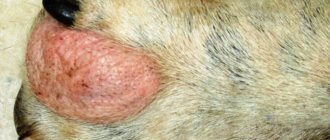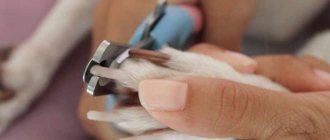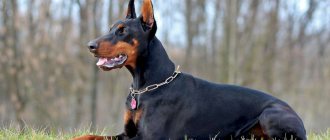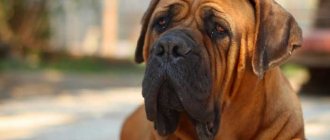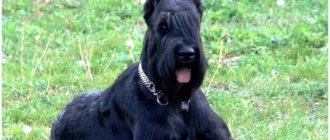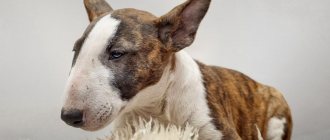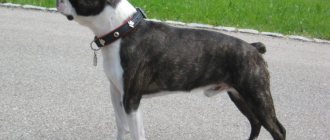Paw diseases in dogs are among the most common pathologies. The reasons may be banal splinters and cuts.
Lameness and pain accompany all paw diseases in dogs; you should not try to cope with the problem yourself using “proven” folk methods “that helped your neighbor’s pet.” Each specific case requires an individual approach.
Treatment of paw diseases at home will not bring results if we are talking about the development of gangrene, crushing of limb tissue, the presence of tumors, ingrown claws and other pathologies that require surgical intervention.
Common paw diseases in dogs
Conventionally, all major paw diseases in dogs can be divided into several groups:
- Lesions of the paw pads and interdigital spaces.
- Mechanical damage to nails.
- Inflammation of joints of various etiologies.
- Degenerative changes in joints.
- Osteoporosis and osteomalacia.
- Violation of bone integrity.
- Dislocations.
- Sprains and ligament tears.
- Convulsions and paralysis.
- Dermatitis.
- Infectious lesions of soft tissues.
The reasons for the development of the presented pathologies are:
- hereditary factors;
- anomalies of intrauterine and postnatal development;
- feeding errors causing insufficient intake of proteins, vitamin D, calcium, phosphorus;
- low or excessively high levels of physical activity;
- injuries;
- excess weight;
- age-related changes in the body;
- improper care;
- failure to comply with pet hygiene rules;
- infectious and invasive diseases;
- allergic reactions.
Why does an extra finger appear?
Experts say that the appearance of an extra toe in a dog is a manifestation of atavism. Atavism is a biological process of manifestation in an animal of signs of the class or group whose representatives participated in the breeding of this organism. Over time, these signs lose their functions.
If we talk about how many fingers most dogs should have, then according to the law of biology - 5, perhaps, like their distant genetic ancestor - the wolf. This means that the appearance of an extra finger is a natural pattern.
There is still a debate among experts about why some puppies develop such a toe and others do not. There is an opinion that this is due to the fact that the sign of the appearance of an extra element is a suppressive process. And if you cross a male with five fingers with a female with a normal paw, then the puppies will most likely be born like the father.
Breed characteristics
Due to breed characteristics, some dogs have a hereditary predisposition to certain diseases of the paws and the entire musculoskeletal system.
Note! The presence of a predisposition does not yet guarantee the occurrence of pathology. Proper care, feeding and regular preventive examinations will help to avoid or delay their manifestation.
Diseases of small breed dogs
The recent widespread fashion for miniature dogs has led to the appearance of animals with a body weight of no more than one kilogram.
Interesting! For the full functioning of all organs and systems, the body weight of an adult must be at least 1.5 kg. With less weight, abnormal changes occur, leading to the development of deformities or premature death.
- Deformation of the elbow joints. Dachshunds, Bassets, French Bulldogs and Pekingese have increased load on the forelimbs due to uneven distribution of muscle mass. This gradually leads to bone deformation and muscle atrophy. Clinically, the pathology is manifested by lameness and gradual “weight loss” of the front legs.
- Osteochondrosis . Degenerative changes in cartilage lead to damage to the joints of the limbs and the spinal column. The breed's tendency of dwarf dogs to develop the disease is due to the insufficient development of the network of small blood vessels that provide nutrition to the cartilage tissue. Symptoms of osteochondrosis are: enlargement and pain of the affected joints;
- difficulty getting up and changing body position after sleeping or staying in one position for a long time;
- falling to one side when sitting.
Progression of the disease leads to loss of control of the affected paws, but their sensitivity remains.
Treatment is carried out only by a veterinary specialist after a full examination using fluoroscopy. Depending on the stage of development, analgesics, non-steroidal anti-inflammatory drugs, vitamins B and C, manganese, zinc, and chondroprotectors are used. The animal’s diet is reviewed, physiotherapy is prescribed, and in some cases hormone therapy is used.
- Lagg-Calv-Perthes disease. It is characterized by the appearance of necrotic foci of the head and neck of the femur, caused by insufficient blood supply. The pathology begins to manifest itself in young dogs aged 6 to 7 months with a limp on one of the hind limbs, decreased mobility of the hip joints, pain at the point of contact, and muscle atrophy. Any careless movement or additional physical activity can lead to a bone fracture. Depending on the stage of development of the pathology, conservative treatment is prescribed to relieve inflammation, eliminate pain, stop further destruction of bone tissue, or surgical excision of the affected tissues with their subsequent replacement with an artificial analogue.
- Increased injury rate. The miniature size of the pet means that accidental squeezing, hitting, or jumping from a height exceeding their height leads to fractures of the limbs or spinal column. The situation is aggravated if the dog is obese, in which excess weight creates additional stress on the musculoskeletal system.
Diseases of large breed dogs
The list of the most common diseases of large breed dogs includes arthritis and joint dysplasia, which develop as a result of intense physical activity. Ulnar hygroma is often reported in Great Danes and large varieties of greyhounds.
- Arthritis . A joint disease that is inflammatory in nature and develops against the background of bruises or constant excessive physical exertion. Symptoms of the disease are pain, swelling, hyperemia, crunching of joints during movement, flexion and extension of the limbs. In acute inflammation, there is an increase not only in local, but also in general body temperature. In the absence of proper treatment, pathogenic microflora can penetrate into the joint, threatening the development of sepsis.
Therapeutic measures for non-infectious arthritis include the use of anti-inflammatory and painkillers, chondroprotectors, changes in diet, physiotherapeutic procedures, and swimming.
- Joint dysplasia. The disease is the destruction or degeneration of the tissues of the articular surfaces, provoked by improper contact of the head of the bone and the articular notch. The most common is hip dysplasia, which is characteristic of massive breeds such as Rottweilers, German Shepherds, St. Bernards and Newfoundlands. The pathology manifests itself as a wobbling gait, stiffness of movements, a desire for frequent rest, and pain on palpation of the affected area.
In second place is dysplasia of the elbow joint, accompanied by lameness, difficulty climbing stairs, pain in the forelimbs, and an increase in the volume of the joints.
Important! The high degree of hereditary factor suggests that all puppies whose parents suffered from joint dysplasia are automatically at risk. Therefore, decent breeders reject such producers from the breeding business.
- Ulnar hygroma. The disease is characterized by the formation of a non-painful lump with a diameter of 6 to 10 cm on the back surface of the elbow joint. This occurs as a result of the accumulation of mucous secretion, which begins to be intensively synthesized by the glands located in the joint capsule. At present, the exact cause of the pathology has not been established, but experts have established a genetic predisposition to it in representatives of such breeds as St. Bernards, German and Central Asian shepherds, Dobermans and Giant Schnauzers. Timely surgical treatment in most cases gives positive, stable results and prevents relapses of the disease.
Veterinarian help
Depending on the condition of the animal and the cause of the disease, the veterinarian may recommend medication or surgery. Until this point, you should stop taking medications - this may simply make it difficult to make a diagnosis.
Establishing diagnosis
In addition to visual inspection and palpation (feeling), diagnosis requires mandatory x-rays. It allows you to evaluate changes in the affected tissues. Additional research methods include histology, cytology and CT, and if infection is suspected, a blood test.
Prescription of medications
All diseases considered are treated with chondroprotective drugs that slow down and stop the destruction of cartilage. Other drugs are prescribed based on accompanying symptoms:
- glucocorticosteroids and anti-inflammatory drugs that suppress the inflammatory response;
- anabolic steroids that promote weight restoration and growth of damaged tissue;
- antispasmodics and analgesics that eliminate muscle spasms and pain;
- antibiotics that fight infection;
- warming ointments and gels that normalize blood circulation.
Please note that the effectiveness of chondroprotectors decreases with the development of the disease. They are used only in the early stages or as a preventative measure. In all other cases, you have to resort to surgery.
Probability of surgery
Surgery is resorted to when there is no effect from taking medications. The affected area is immobilized or amputated, replacing it with a prosthesis. In both cases, it is possible to eliminate pain and maintain partial mobility.
Age-related paw diseases in old dogs
Widespread age-related paw diseases in old dogs are arthrosis and osteoarthrosis.
Arthrosis is a chronic disease accompanied by degeneration of articular cartilage. When the pathology spreads to other anatomical structures of the joint, osteoarthritis develops, leading to deformation of the organ and loss of its function.
These diseases have a number of characteristic clinical signs:
- inactivity accompanied by a reluctance to go for a walk;
- pain and crunching in the joint area when walking;
- falling on the affected limb;
- enlarged joints;
- increase in local temperature.
The radical and only effective treatment for arthrosis is joint replacement. However, the high cost of the operation, the lack of materials and equipment in most clinics, as well as the low qualifications of veterinarians, make this manipulation inaccessible to most owners of elderly animals.
Conservative methods of therapy, based on the use of anti-inflammatory and painkillers, chondroitin and glucosamine preparations, can only stop tissue destruction and temporarily alleviate the condition.
- Rheumatism can be considered another age-related pathology. But it is worth mentioning that this disease is registered even in six-month-old puppies kept in poor conditions or exposed to hypothermia.
The main cause of rheumatism is considered to be a streptococcal infection that affects the soft tissues of the body after a pet has suffered pharyngitis, tonsillitis and other infectious pathologies of the ENT organs.
Staffordshire terriers, chow chows, poodles, and Pekingese are genetically predisposed to the disease.
Symptoms of rheumatism during exacerbation of the disease:
- intermittent claudication;
- the desire to minimize movements performed;
- soreness of various muscle groups;
- frequent stops while walking;
- refusal to overcome even minor obstacles or climb stairs.
Note! After a period of exacerbation, a stage of short-term remission begins, during which the dog seems healthy. Rheumatism is an incurable chronic pathology that most often manifests itself in the off-season.
Conservative
Conservative treatment methods are rarely used. The doctor realigns the displaced bone fragments, followed by immobilization. To immobilize the damaged bone, he uses a special bandage that limits the movement of the paw.
It can be removed in 1-1.5 months. For small breeds this period is shorter—about 20 days; for older dogs it is longer—up to 50-60 days. Throughout the entire period, care must be taken to ensure that there is no compression of the soft tissues by the splint.
[custom_ads_shortcode3]
Diseases by location
There is a classification of diseases according to location, which makes it possible to quickly make a diagnosis and begin treatment.
Front legs
Having noticed that the pet has begun to limp on its front legs, owners should conduct a thorough examination, which will help identify the causes of this symptom.
- Cuts, splinters or soft tissue burns. With these pathologies, lameness begins to appear suddenly during a walk. When cutting the fingertips, there is always heavy bleeding, since this area has a well-developed network of blood vessels. You can stop the bleeding by applying a tourniquet or tight bandage slightly above the wrist joint.
Note! If, after a cut, the dog cannot lean on its paw and at the same time strongly bends it under itself, then this indicates damage to the ligaments. Unfortunately, complete dissection of the ligaments does not recover on its own, and even surgical treatment does not guarantee a 100% result.
The presence of a burn is indicated by a change in the color and structure of the top layer of tissue on the crumbs. The affected area should be treated first with an antiseptic solution (Chlorhexidine), then with Panthenol and apply a sterile bandage. If there is severe pain, you can apply a few drops of anesthetic (novocaine, lidocaine) to the wound.
Important! In case of chemical burns, do not wash the affected surface with water. Acids should be neutralized with a solution of baking soda (5 g of soda per 0.5 liter of water), and alkalis with a weak solution of acetic acid. After this, thoroughly rinse off the remaining substance with water.
- Sprains, dislocations or fractures resulting from an unsuccessful jump, fall or compression. These pathologies are accompanied by very severe pain. The animal cannot stand on the affected limb. The paw becomes hot, swollen, sometimes deformed or hanging lifelessly. Only a veterinarian can make an accurate diagnosis and provide qualified assistance.
- Claw injuries. A nail broken at the root causes severe pain to the pet and causes lameness. You should not try to remove the remains of the damaged plate yourself, as this can lead to bleeding and cause severe pain.
- Ingrown nails. In dogs that rarely walk outside, the nail plate does not naturally wear off, and its sharp edge, bending, grows into the pad of the finger. The pet cannot fully step on its paw, twists it, limps and tries to get rid of the source of pain. Treatment is surgical excision followed by antiseptic treatment, carried out only by a veterinary specialist.
- Arthritis, arthrosis. Deformation of the articular surfaces is accompanied by limited mobility of the animal, lameness, pain and enlargement of the joints, which produce a characteristic crunch when walking.
- Elbow dysplasia. Degenerative changes in joint tissues lead to the development of lameness, the appearance of a painful syndrome, an increase in joint volume, and stiffness of movement.
- Osteosarcoma. Cancerous lesions of the bone tissue of the forelimbs in the initial stage do not manifest clinical symptoms. As the malignant tumor grows, progressive pain, swelling, and limited mobility of the nearby joint appear. If left untreated, spontaneous bone fractures may occur as a result of thinning bone tissue. Surgical treatment consists of excision of the tumor. Subsequent therapy is aimed at preventing metastasis and relapse of the disease.
- Radial nerve palsy. The cause of the development of pathology is bruises, inflammation, and fractures of the bones of the shoulder girdle. At rest, the pet keeps its paw in a semi-bent state, and when walking, it jerks it forward. With complete paralysis, stepping on the front limbs becomes impossible.
Hind legs
Diseases of the hind legs are provoked by injuries, degenerative changes in bones and joints, infectious agents and hereditary factors.
- Injuries to the bones of the hind limbs and pelvis. Pathologies arise as a result of blows, squeezing, falling, gunshot and knife wounds. During treatment, a splint, plaster cast, or surgery using osteosynthesis is applied to the damaged paw.
- Sprains and ligament tears. The cause may be excessive physical exertion and unsuccessful landings after jumping. Clinical manifestations include lameness, tenderness to pressure, and small subcutaneous hemorrhages or hematomas. In the first hours, a cold compress is applied to the damaged area, local and general anesthetics are used, and the pet’s movement is limited. Subsequently, the doctor may prescribe physiotherapeutic procedures.
- Arthritis, arthrosis and dysplasia of the joints of the hind limbs. An effective treatment is joint replacement surgery. Conservative methods using anti-inflammatory drugs and chondroprotectors provide temporary relief and help slow down the destruction process.
- Sciatic nerve palsy . The causes are injuries to the soft tissues of the hind limbs, fractures of the pelvic bones, exposure to infectious agents and toxic substances, long-term pinched nerves, diseases of the brain and spinal cord. Partial paralysis is manifested by stiffness of gait, arching of the back, and gradual loss of sensitivity in the affected area. With complete paralysis, the animal moves only on its front legs. Even with correct and timely treatment aimed at eliminating the etiological factor, the prognosis remains cautious or unfavorable
- Dislocation of the kneecap. It is registered in representatives of all breeds, but is more common in Yorkies, miniature poodles and Chihuahuas. For this pathology, conservative treatment is ineffective. It only allows for short-term relief of pain and inflammation. With the help of surgical methods it is possible to completely cure the animal.
Paw pads
Diseases of the paw pads can be traumatic and inflammatory in nature.
- Cuts. Dissection of the soft tissues of the pads is accompanied by profuse bleeding. Significant blood loss can be prevented by applying a tight bandage to the paw and applying ice or any cold object.
- Penetration of sharp objects. If during a walk the dog suddenly yelps and begins to limp, then the cause may be a piece of glass, wood or metal stuck into the pad.
- Burns. Thermal skin damage occurs when a dog steps on hot objects, tar stains, hot asphalt or sand in the hot season. Chemical burns occur when paw pads come into contact with acids, alkalis, solvents, or quicklime.
- Pododermatitis. An inflammatory process that occurs on the paw pads as a result of allergic reactions, penetration of infectious agents, hormonal disorders, diabetes mellitus, autoimmune diseases, malignant growths and exposure to aggressive agents (salt, building mixtures, fuels and lubricants, etc.). Treatment is aimed at relieving symptoms and eliminating etiological factors.
Between the toes
The cause of inflammation of the skin between the toes is interdigital dermatitis.
Causes and symptoms of the disease:
- mechanical damage - cuts, scratches, abrasions, punctures, presence of foreign objects;
- exposure to chemical agents - itching, hyperemia, swelling, small blisters filled with serous exudate;
- allergic reaction - severe itching, in which the dog constantly wets the affected surface with saliva and licks the affected surface, causing tissue maceration, the development of eczema and hair loss;
- bacterial infections - hyperemia, increased local temperature, formation of ulcers, pain;
- pathogenic fungi - hair loss, severe itching, peeling;
- demodicosis - the appearance of hairless areas with a bubble in the center, from which, when pressed, a drop of transparent exudate is released;
- skin parasites - severe itching, scratching, rash, redness;
- stress factor - itching, rash, hyperemia.
Note! If the dog tries to gnaw something between the toes, then a thorough examination should be carried out for the presence of a foreign body or ixodid ticks. If parasites are detected, you must go to the clinic and donate blood for piroplasmosis.
Skin diseases
There is an impressive list of skin diseases that affect the limbs of dogs. They have both common and distinctive symptoms that make it possible to identify the pathology:
- trichophytosis and microsporia - itching, peeling, hair loss or breaking off;
- pityrosporosis (caused by the yeast Malassezia pachydermatis) - the appearance of hairless, weeping areas at the base of the nail, emitting an unpleasant putrid odor and itching;
- flea dermatitis - rash, itching, scratching;
- allergic reactions - itching, redness, swelling;
- pyoderma - pustular rashes, increased local temperature, hyperemia, itching;
- seborrhea - excessive peeling, severe itching, dry and brittle nails, hyperemia, hyperkeratosis of the fingers;
- sarcoptic mange - constant severe itching, rash on the elbow and hock joints, turning into bursting blisters, scales and dried crusts, the appearance of alopecia;
- Oncological dermatitis is a painless growth of tissue in the form of ulcers, nodules, bumps, erosions or rashes.
Treatment is prescribed by a veterinarian depending on the symptoms and individual characteristics of the pet’s body.
Joint diseases
The classification of diseases of the joints of the extremities includes pathologies of a degenerative, inflammatory, infectious and traumatic nature. Each disease is manifested by corresponding symptoms:
- arthrosis - increased and impaired joint mobility, crunching during movement, pain at the last stage of development;
- osteoarthritis - lameness and pain, worsening after sleep, increasing powerlessness and immobility over time, caused by severe pain in deteriorating joints;
- purulent arthritis - general depression, fever, pain and enlargement of the joint, decreased appetite or refusal to feed, lameness;
- hemarthrosis (joint hemorrhage as a result of injury) - pain, smoothing of the joint relief, severe lameness, increased local temperature, fever;
- dislocations - pain, swelling and increased temperature in the area of the affected joint, limited mobility, unnatural position of the limb;
- hip dysplasia - stiffness of movement, pain, wobbling gait;
- dysplasia of the elbow joints - problems when climbing stairs, pain and increased volume of the joints, lameness;
- joint wounds - violation of the integrity of the skin, soft tissues, synovial bursa and other anatomical structures of the joint, purulent inflammation (if the wound becomes infected);
- aseptic synovitis - hot swelling in the joint area, hyperemia, pain of varying intensity;
- infectious synovitis - acute pain accompanying purulent melting of joint tissues, fever, blocking limb mobility, hyperemia (if left untreated, sepsis develops and death occurs);
- traumatic synovitis - hemorrhages on the skin in the area of the injured joint, swelling filled with blood exudate, increased local temperature, pain.
As treatment, the doctor prescribes analgesics and anti-inflammatory drugs. If the integrity of the joints is violated or degenerative changes form in them, surgical treatment is used. In the presence of infectious processes, antibiotic therapy is necessarily prescribed.
Claw diseases
Claw diseases often affect sedentary and sick pets whose nail plates do not wear off naturally.
Important! Only an experienced specialist should trim nails, since without knowing the anatomical location of the neurovascular bundle located inside the plate, you can cause severe pain to your pet and cause heavy bleeding.
There are a number of other claw diseases.
- Ingrown nail. Excessively grown nails, bending, dig into the pads of the paws, pierce the top layer of skin and grow into soft tissues. The pain syndrome intensifies when pathogenic microflora enters the wound, causing purulent inflammation. Treatment involves surgical excision of a section of the nail plate and treatment of the wound with an antiseptic drug.
- Felon. Purulent inflammation of the nail rim, resulting from infection of damaged tissue. In order to prevent the development of sepsis, the veterinarian makes a puncture, applies a bandage moistened with an antiseptic, and additionally prescribes treatment with antibacterial ointments. In advanced forms of panaritium, surgical excision of the affected tissue is required, and in case of threat of sepsis, amputation of the phalanx is required.
- Claw injuries. Cracks and breaking of the nail plates cause severe pain and can cause bleeding. The damaged nail must be carefully trimmed with nail clippers, treat the wound with antiseptic ointment and apply a bandage. If the nail breaks off completely and there is heavy bleeding, you should contact a veterinary clinic.
- Fungal infections. Pathogenic fungi cause peeling of nails and excessively rapid death of the stratum corneum. The adjacent skin is gradually affected and the nail matrix is destroyed, causing it to fall off. Treatment with antifungal and anti-inflammatory ointments is used as treatment. In case of advanced infection, antimycotics are prescribed in tablets.
The cause of claw delamination can be autoimmune diseases and vitamin deficiencies in the diet. In this case, only a veterinarian can correctly diagnose and select therapeutic methods.
Operational
Most cases (approximately 90%) of limb fractures in dogs require surgery. Osteosynthesis is performed (an operation to fuse bones) using pins, staples, screws, and plates. In recent years, with the development of new technologies, veterinarians began to use not only metal devices, but also polymer ones.
High-quality structures can withstand loads similar to those on healthy limbs. After the bones physiologically return to their previous state, the consumable material is removed. Several types of treatment are used in surgical practice. More details about them:
- Kishner apparatus. A design made of a metal rod and self-tapping rods is used for intra-articular fractures.
- Ilizarov apparatus. It is presented with knitting needles and metal rings that reliably fix bone fragments.
- Internal fixation. The most difficult operation. The surgeon must have the necessary qualifications and sufficient experience to perform it efficiently. The pins are inserted directly into the long bones. They are not removed over time, but remain for life.
All surgical interventions are performed under general anesthesia. The best option is inhalation anesthesia. Doctors say that the animal endures the operation easier and recovers faster.
[custom_ads_shortcode1]
Diseases by symptoms and manifestations
Systematization of diseases by symptoms and manifestations helps owners quickly recognize the pathology, contact a specialist in time and competently provide first aid to their pet.
Paralysis, paws are taken away (fail), the dog may fall
Diseases in which paralysis develops, paws are taken away (failure), the dog may fall and be unable to get up on its own, are hidden for a long time. They are often the result of road accidents, impacts, falls, and degenerative processes of the spinal column and joints.
- Violation of the innervation of the limbs. The formation of a hematoma in the spinal column can lead to compression of the peripheral nerves that transmit impulses to the front or hind legs. The reversibility of the process allows us to give a favorable prognosis. As an additional treatment, doctors prescribe massage of the limbs to improve blood supply and prevent muscle tissue atrophy.
- Intervertebral hernia. Protrusion of the nucleus pulposus of the intervertebral disc beyond the anatomical boundaries, accompanied by rupture of the fibrous ring and compression of the nerves, is more often recorded in elderly dogs. At the initial stage, the dog becomes inactive and lethargic; when trying to stand up, its hind limbs give way, and touching the area of the spinal column causes pain. Subsequently, complete paralysis develops, which can only be treated with surgery.
- Spondylosis. A chronic disease that develops as a result of impaired trophism of the intervertebral discs. As a compensatory mechanism, osteophytes (salts) begin to form on them, which gradually lead to loss of mobility of the vertebrae. At this stage, dogs exhibit paresis and paralysis of the limbs. This phenomenon is irreversible and cannot be treated.
- Infectious diseases. A fall on the hind limbs, paresis and paralysis can be symptoms of meningitis, encephalitis, canine distemper, and rabies.
- Tumors of the spine. Benign or malignant formations can compress intervertebral discs and nerve endings, leading to paresis and paralysis. The animal begins to arch its back unnaturally and show anxiety when palpated. If the innervation of internal organs is disrupted, involuntary urination and defecation may occur.
- Osteochondrosis. Severe dystrophic disorders of cartilage tissue in joints lead to loss of mobility and increased pain. The dog lies in an unnatural position, whines, refuses food, and attempts to get up are often unsuccessful.
- Dysplasia of the hip and elbow joints. Destruction of the articular surface at the initial stage is manifested by lameness after lying down, rapid fatigue, and unnatural gait. When moving into a severe stage, the limbs become immobile, and the pet loses the ability to move.
The legs are weak, the dog cannot stand
If your pet's paws are weak, the dog cannot stand and falls over on one side, then this may indicate the development of protrusion. With this pathology, protrusion of the intervertebral disc occurs without violating the integrity of the fibrinous capsule. If left untreated, a hernia may develop, resulting in paralysis of the limbs.
In some older dogs, degenerative myelopathy causes an unsteady gait and poor coordination in the hind legs. Characteristic signs of the disease are also the absence of pain, urinary and fecal incontinence.
Ulcers and wounds of various etiologies, paws fester
If your pet has ulcers and wounds of various etiologies, and its paws fester, this may indicate the presence of the following pathologies:
- cuts, splinters, puncture wounds infected with pathogenic microflora;
- chemical and thermal burns complicated by the development of pyogenic bacteria;
- oncological and parasitic dermatitis, severe itching in which scratching provokes.
Infected wounds are cleaned of pus and dead tissue, treated with antiseptic, healing and anti-inflammatory drugs. In severe cases, antibiotic therapy is prescribed.
Tumors on the paws
The presence of tumors on the paws may indicate the following diseases:
- hematoma resulting from a blow;
- abscess;
- benign and malignant neoplasms;
- hygroma of the elbow joint;
- papillomas and warts.
The similarity of symptoms makes it difficult to make a diagnosis at home, so if a tumor appears, consultation with a veterinary specialist is necessary.
Fungus on paws
The appearance and development of fungus on the paws can be a consequence of poor hygiene, infection from other animals, a sharp decrease in immunity, or uncontrolled use of medications.
Symptoms of dermatomycosis are:
- change in the structure of the claws, partial or complete separation;
- peeling on the fingertips, the formation of cracks, wounds and ulcers on them;
- swelling in the fingers and joints;
- alopecia;
- hyperemia;
- severe itching.
Depending on the etiology of the disease, vaccination and treatment with antifungal ointments are carried out. If wounds are colonized by pathogenic bacteria, local or general antibiotic therapy is prescribed.
Lumps and swellings on the paws
The causes of bumps and swelling on the paws are:
- abscesses;
- phlegmon;
- hematomas;
- insect bites and skin parasites;
- allergic reactions;
- benign and malignant growths;
- compactions after injections of medications.
The danger is posed by purulent processes that can lead to the melting of a large volume of tissue, sepsis or compression of nerve endings. Therefore, when they appear, you need to contact a veterinary clinic.
Hair loss on paws
The following pathologies can provoke hair loss on the paws;
- dermatitis of various etiologies;
- pododermatitis;
- pyoderma;
- cutaneous parasites;
- subcutaneous mite;
- fungal infections;
- allergic reactions;
- burns;
- insufficient intake of vitamins and minerals;
- severe or prolonged stress.
Prescription of treatment is possible only after an accurate diagnosis and elimination of the etiological factor.
The dog stretches out its paws
If a dog stretches its paws during a convulsive seizure, this indicates the presence of one of the pathologies:
- epilepsy;
- tumors or injuries of the brain and spinal cord;
- poisoning;
- consequences of exposure to electric current;
- rabies, encephalitis, meningitis;
- hypoglycemia.
Treatment only under the supervision of a veterinarian.
Dog chewing his paw
The reasons why a dog chews its paw can be:
- itching resulting from poor hygiene, fungal infections;
- the presence of skin parasites;
- joint pain;
- allergic reactions;
- numbness of the limbs.
Paws cramp like cramps
When a dog’s paws cramp, this indicates diseases associated with pathologies of internal organs and metabolic disorders:
- hepatitis;
- nephritis;
- meningitis;
- heart failure;
- hypoglycemia;
- obesity;
- impaired absorption of nutrients in the intestine;
- oncological lesions of the brain and spinal cord.
Among the infectious diseases, it is worth highlighting canine distemper, rabies and encephalitis.
The dog tucks its paw or limps
If the dog tucks its paw or limps, this indicates an extreme manifestation of the pain syndrome. This condition is provoked by:
- limb fracture;
- a severe cut, burn, puncture wound, or gunshot wound;
- ligament rupture;
- dislocation of the kneecap;
- intervertebral hernia;
- severe form of joint dysplasia.
The paw shakes involuntarily
During times of severe stress or a significant drop in ambient temperature, the dog’s paws involuntarily shake, which is normal. But if a similar sign is observed at rest, then this may indicate the following pathologies:
- a sharp decrease in the concentration of potassium and glucose in the blood;
- compression of the spinal cord nerve roots by hernias, cysts, hematomas or tumors;
- intestinal, hepatic or renal colic, accompanied by severe pain;
- leptospirosis.
Note! Unlike humans, dogs do not suffer from Parkinson's disease.
Treatment at home
Diseases in the initial stages can be treated at home. In addition to taking medications, the animal will need massages and special compresses to eliminate associated symptoms.
Massages
This physiotherapy is used to improve blood circulation and relax muscles. Massage is prescribed to all four-legged patients whose illnesses are not associated with infection. Otherwise, the inflammation may become purulent and spread to surrounding tissues.
Compresses
If there are hematomas, a compress of lavender and juniper is effective. To prepare it, you need to mix 2 drops of both essential oils with a glass of water. A cloth soaked in the resulting solution must be applied to the sore spot for 10-30 minutes.
To relieve acute pain and inflammation, a compress made from raw potatoes is suitable. Its preparation is similar to potato pancakes. The potatoes grated on a medium grater must be squeezed out, mixed with a few drops of honey and applied thickly to the sore spot.
Ointments and gels
All ointments are applied to dry surfaces, previously cleaned with an antiseptic. Due to their fat content, they take a very long time to be absorbed, so immediately after application they are carefully rubbed and hidden under a bandage.
The gel is applied according to the same principle. The only difference is that due to the absence of fats and oils, it is quickly absorbed even when rubbed.
Can I give painkillers?
Giving drugs without a prescription is very dangerous, as most human analgesics are toxic to pets. You can give a pill or give an injection strictly after consulting with a veterinarian - at least by phone.
Prevention of paw diseases in dogs
By following a few simple rules for preventing paw diseases in dogs, you can avoid the development of most pathologies.
- When choosing a puppy, it is advisable not only to study the pedigree of the parents, but also to see them live in order to exclude the presence of pathologies of the musculoskeletal system and other developmental anomalies.
- From the first days of life, provide your pet with nutritious feeding, balanced in the amount of nutrients, calcium, phosphorus and other minerals and vitamins.
- Prevent the development of obesity.
- Offer your pet physical activity commensurate with its size, body weight, breed characteristics, age and physiological condition.
- Treat infectious and invasive diseases, allergies and dermatitis in a timely manner. Treat skin parasites in a timely manner.
- During walks, avoid places near landfills, construction sites, service stations and industrial enterprises, where the dog can injure its leg on a sharp object or receive a chemical burn.
- Select “friends” of approximately the same age and size for your pet’s company. Larger or more active animals provoke excessive mobility of their smaller counterparts, which leads to sprains, dislocations and bruises.
Types of fractures
Veterinarians distinguish several types of fractures, each of which has its own characteristics. More details about them:
- Crack. The mildest form, most often there are no symptoms at all. It can be confused with a bruise. Sometimes the animal’s cautious gait or slight lameness is alarming. At the same time, the pet remains active. Pathology can be diagnosed only after an X-ray examination.
- Hammered. It occurs mainly in puppies and large breed dogs. It is not accompanied by severe damage to internal tissues, the clinical picture is blurred. Bone fragments fit into each other. If assistance is not provided in a timely manner, they may become displaced.
- Closed without displacement. Damaged bones remain in place. There is noticeable pain and impaired motor function.
- Closed with offset. The bones are not only damaged, but also change their anatomical position. There is a risk of injury to organs and large vessels.
- Open. Severe injury with damage to bones, internal tissues, and joints. There may be ruptures of blood vessels.
[custom_ads_shortcode2]
Hygiene issues
Paws require special care, no matter how many toes a dog has. Hygiene issues become important when dogs live in the same premises as their owners. The animal must be walked twice a day in all weather conditions, which include bacteria, dirt and dust.
Dirt, dust and small particles can be absorbed into the skin and harm the pet's health. This means that it is not enough to simply wipe the dog’s paws with a dry cloth; a thorough wash is necessary.
Only proper and regular care will ensure good health for your pet.
